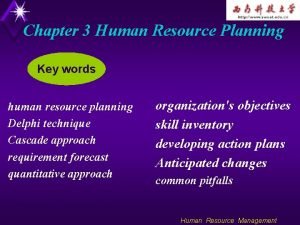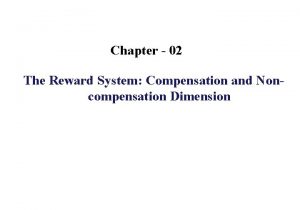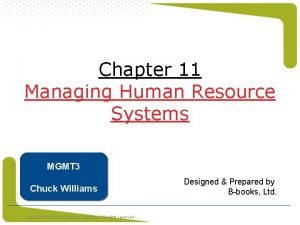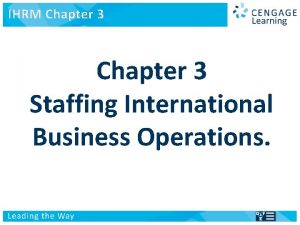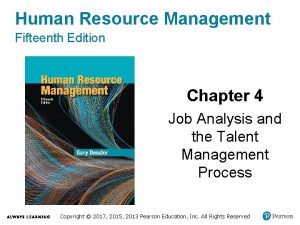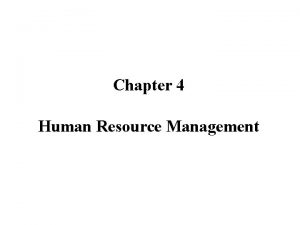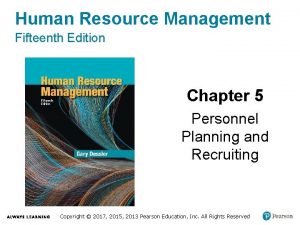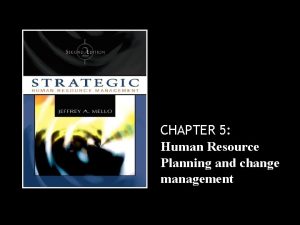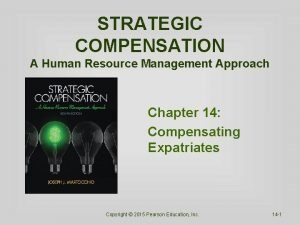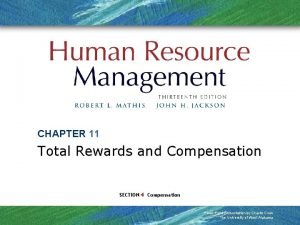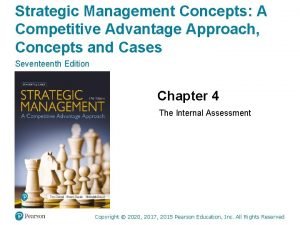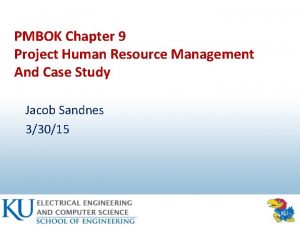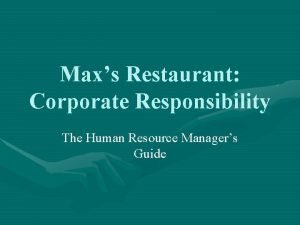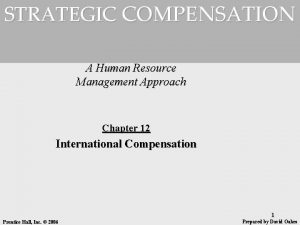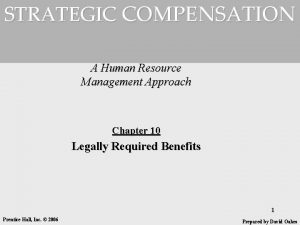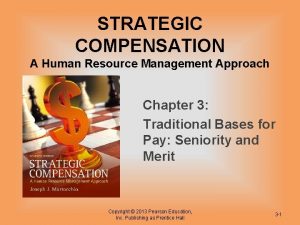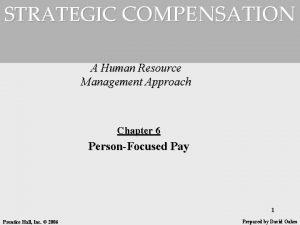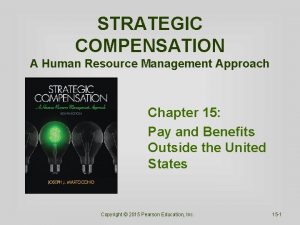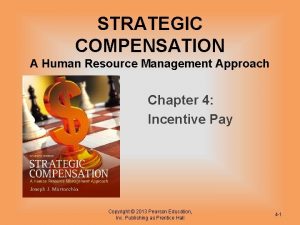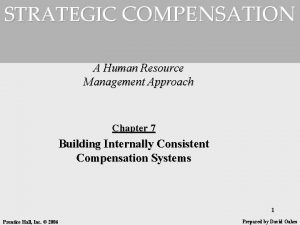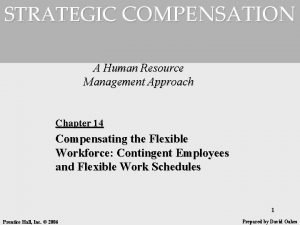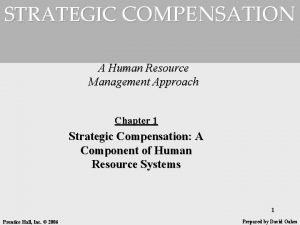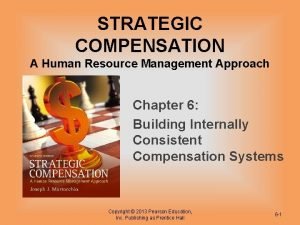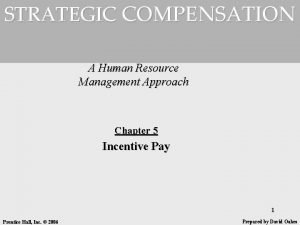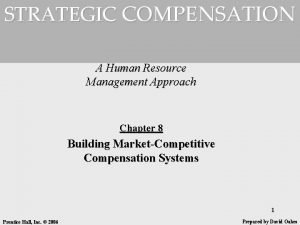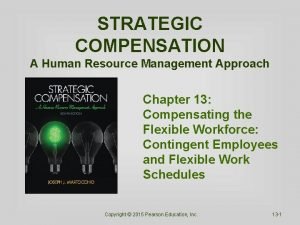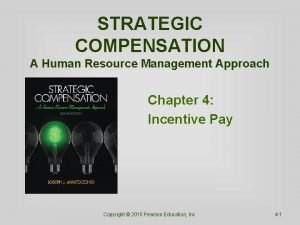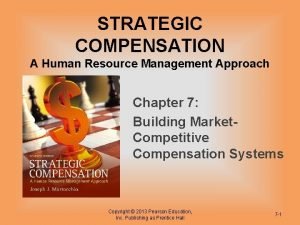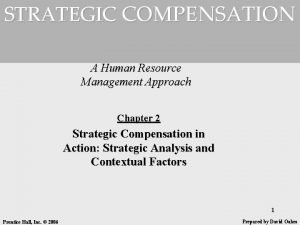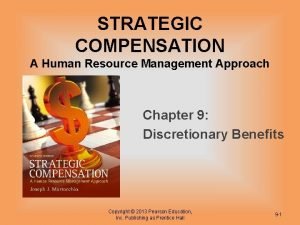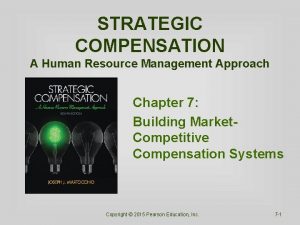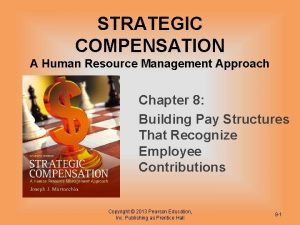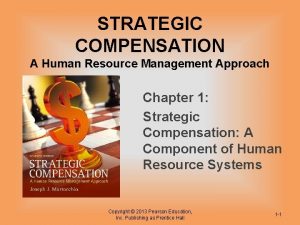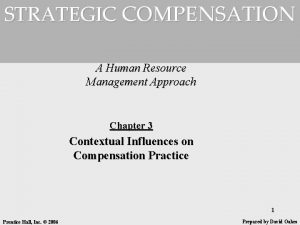STRATEGIC COMPENSATION A Human Resource Management Approach Chapter



































- Slides: 35

STRATEGIC COMPENSATION A Human Resource Management Approach Chapter 16: Challenges Facing Compensation Professionals Copyright © 2015 Pearson Education, Inc. 16 -1

Learning Objectives 1. Explain the impact of economic recession and underemployment on compensation practice. 2. Point to the reasons for rising wages in China. 3. Describe the challenges associated with executive compensation. 4. Summarize the challenges associated with health care reform. Copyright © 2015 Pearson Education, Inc. 16 -2

Learning Objectives 5. Describe the influence of changing workforce demographics on employee benefits practice. 6. Summarize the issue of marriage between samesex individuals and the U. S. Supreme Court ruling on the Defense of Marriage Act. Copyright © 2015 Pearson Education, Inc. 16 -3

Learning Objective 1 Explain the impact of economic recession and underemployment on compensation practice. Copyright © 2015 Pearson Education, Inc. 16 -4

Fallout from the “Great Recession” • Economic recession – Between December 2007 and June 2009 – 19 months – “Great Recession” – The longest recession since WWII Copyright © 2015 Pearson Education, Inc. 16 -5

Economic Recession • Economic recession: general slowdown in economic activity • Evidence of economic recession – Reduced GDP – Increased unemployment rates • Reduced consumer spending • Consumers’ demand for products and services declines – Ex: General Motors and Chrysler cut production levels to avoid excess inventory Copyright © 2015 Pearson Education, Inc. 16 -6

Economic Recession and Layoffs Copyright © 2015 Pearson Education, Inc. 16 -7

Economic Recession and GDP Copyright © 2015 Pearson Education, Inc. 16 -8

Underemployment Copyright © 2015 Pearson Education, Inc. 16 -9

Mean Hourly Wages of Underemployed Persons and Full-Time Wage and Salary Workers, 16 years and Older, by Educational Attainment, October–December 2009 Education group Underemployed Full-time workers Difference All workers $12. 80 $20. 96 $8. 16 High school students 7. 07 8. 20 1. 13 College students 13. 04 12. 67 0. 37 High school dropouts 11. 23 12. 11 -0. 88 High school graduates 11. 78 16. 67 4. 89 1– 3 years of college 13. 83 18. 96 5. 13 Bachelor’s degree 14. 35 26. 17 11. 82 Master’s or higher degree 21. 46 32. 07 10. 61 Copyright © 2015 Pearson Education, Inc. 16 -10

Malemployment • Malemployement occurs when job holders possess greater education, skills, or knowledge than is required to perform their jobs • Ex: – Holds bachelor’s degree in psychology – Part-time grocery store clerk – Underemployed and malemployed Copyright © 2015 Pearson Education, Inc. 16 -11

Compensation-Productivity Gap • The gap between real hourly compensation and labor productivity shows whether workers’ pay is keeping up with productivity – Real hourly compensation – Nominal hourly compensation • Ex: $10 per hour, nominal pay: $10, real pay: $10 – 1 year later, 5% increase in goods and services. Nominal pay: $10, real pay: $9. 5 Copyright © 2015 Pearson Education, Inc. 16 -12

Compensation-Productivity Gap (cont’d) Copyright © 2015 Pearson Education, Inc. 16 -13

Compensation-Productivity Gap (cont’d) Reasons 1. Lower power to bargain for higher pay 2. Profits increase by holding down employees’ pay Copyright © 2015 Pearson Education, Inc. 16 -14

Learning Objective 2 Point to the reasons for rising wages in China. Copyright © 2015 Pearson Education, Inc. 16 -15

Rising Wages in China • Cost of labor has been increasing rapidly • Competitive advantage gained from relocating manufacturing facilities are reduced • Minimum wage rose rates an average of 24% Copyright © 2015 Pearson Education, Inc. 16 -16

Rising Wages in China (cont’d) • Chinese policymakers are supportive of increased wages • Labor shortages – One-child policy Copyright © 2015 Pearson Education, Inc. 16 -17

Learning Objective 3 Describe the challenges associated with executive compensation. Copyright © 2015 Pearson Education, Inc. 16 -18

Challenges in Executive Compensation • Executive compensation practices under scrutiny of many from the public, labor unions, federal government, and some boards of directors Copyright © 2015 Pearson Education, Inc. 16 -19

Challenges in Executive Compensation • Company boards of directors set executive pay • The Dodd-Frank Act requires transparency in setting executive compensation and shareholder advisory vote about their support or lack thereof (“say-on-pay”) Copyright © 2015 Pearson Education, Inc. 16 -20

Executive Compensation: Unanswered Questions • Do shareholders have sufficient knowledge about the qualifications of the executive and whether the proposed compensation package is fitting? • Should all shareholders have an equal say on pay? That is, would it be appropriate to count votes in proportion to the number of shares? • Should we assume that individuals will factor in executive compensation practices as part of their decision to invest in or to divest from a company? Copyright © 2015 Pearson Education, Inc. 16 -21

Learning Objective 4 Summarize the challenges associated with health care reform. Copyright © 2015 Pearson Education, Inc. 16 -22

Challenges in Health Care Reform • PPACA • Goal is to reduce the number of uninsured by 32 million in 2016 • Health Care and Education Reconciliation Act of 2010 adds requirements – Multitude revisions to PPACA – Variety of provisions that will enable more students and families to qualify for student financial aid Copyright © 2015 Pearson Education, Inc. 16 -23

Key Considerations for Employers • Require most employers to provide health insurance to employees • $2, 000 penalty per employee • Expected that cost of health insurance will be more expensive for employers – Elimination of the lifetime benefits cap – Limit waiting period-max of 90 days Copyright © 2015 Pearson Education, Inc. 16 -24

Learning Objective 5 Describe the influence of changing workforce demographics on employee benefits practice. Copyright © 2015 Pearson Education, Inc. 16 -25

Labor Force Diversity • Aging baby-boom generation – Born between 1946 and 1964 – Will be 54 to 72 years old in 2018 Labor force participation rate during the period of 2008– 2018 • Age – Younger workers: 58. 8% 54. 5% – Older workers: 39. 4% 43. 5% Copyright © 2015 Pearson Education, Inc. 16 -26

Labor Force Diversity (cont’d) • Gender – Women: 9% growth – Men: 7. 5% growth • Ethnicity – Hispanic labor force: 30 million – White non-Hispanics: 107 million Copyright © 2015 Pearson Education, Inc. 16 -27

Relevance for Employee Benefits Demographics Unmarried male and female employees (uncoupled employees) Life events benefits Physical fitness programs Generous vacation allowances Employees with dependent elderly parents or relatives Elder care benefits Flexible work schedules Married male and female employees Flexible work schedules Copyright © 2015 Pearson Education, Inc. 16 -28

Relevance for Employee Benefits (cont’d) Demographics Employees with children, male or female, coupled or uncoupled Life events benefits Day care assistance Life insurance Health insurance with dependent coverage Education benefits for children Copyright © 2015 Pearson Education, Inc. 16 -29

Relevance for Employee Benefits (cont’d) Demographics Older workers (nearing retirement) Life events benefits Retirement plans with accelerated benefits accumulation Insurance with prescription drug benefits Generous sick-leave allowances Disability insurance Retiree health care benefits Copyright © 2015 Pearson Education, Inc. 16 -30

Relevance for Employee Benefits (cont’d) • Surveys – Demographics – Needs – Preferences – Recent or anticipated life changes – Preference on benefits Copyright © 2015 Pearson Education, Inc. 16 -31

Learning Objective 6 Summarize the issue of marriage between same-sex individuals and the U. S. Supreme Court ruling on the Defense of Marriage Act. Copyright © 2015 Pearson Education, Inc. 16 -32

Marriage between Same-Sex Individuals • The Defense of Marriage Act of 1996 prohibits recognition of marriage between same-sex individuals. More than a dozen states since that time have instituted laws that legalize same-sex marriage. Copyright © 2015 Pearson Education, Inc. 16 -33

Marriage between Same-Sex Individuals • In fact, until June 2012, the Defense of Marriage Act prohibited same-sex spouses from being recognized as beneficiaries for federal benefits such as Social Security or leave under the Family and Medical Leave Act. Copyright © 2015 Pearson Education, Inc. 16 -34

All rights reserved. No part of this publication may be reproduced, stored in a retrieval system, or transmitted, in any form or by any means, electronic, mechanical, photocopying, recording, or otherwise, without the prior written permission of the publisher. Printed in the United States of America. Copyright © 2015 Pearson Education, Inc. 16 -35
 Cascade approach in human resource management
Cascade approach in human resource management Compensation and non compensation dimensions
Compensation and non compensation dimensions Time management in human resource management
Time management in human resource management Retail store organizational structure
Retail store organizational structure Hrm vs hrd
Hrm vs hrd Strategic human resource
Strategic human resource Human resource management chapter 2
Human resource management chapter 2 Chapter 9 human resources management
Chapter 9 human resources management Chapter 11 human resource management
Chapter 11 human resource management Human resource management chapter 1
Human resource management chapter 1 Human resource management chapter 1
Human resource management chapter 1 Management fifteenth edition
Management fifteenth edition Human resource management lecture chapter 1
Human resource management lecture chapter 1 Types of international assignment in ihrm
Types of international assignment in ihrm Chapter 4 job analysis and the talent management process
Chapter 4 job analysis and the talent management process Function of hrm
Function of hrm Chapter 7 human resource management
Chapter 7 human resource management Chapter 7 human resource management
Chapter 7 human resource management Human resource management chapter 4
Human resource management chapter 4 Project management chapter 4
Project management chapter 4 Replacement chart
Replacement chart Human resource management chapter 5
Human resource management chapter 5 Chapter 11 human resource management
Chapter 11 human resource management Strategic compensation
Strategic compensation Industrial organization model of above average returns
Industrial organization model of above average returns Tows matrix
Tows matrix Compa ratio
Compa ratio Incremental approach in strategic management
Incremental approach in strategic management Strategic management a competitive advantage approach
Strategic management a competitive advantage approach Commander approach in strategic management
Commander approach in strategic management Project human resource management pmbok ppt
Project human resource management pmbok ppt Human resource management pmbok
Human resource management pmbok About human resource management
About human resource management Human resource management in restaurants
Human resource management in restaurants Definition of induction in hrm
Definition of induction in hrm Hrms.shanker group
Hrms.shanker group
